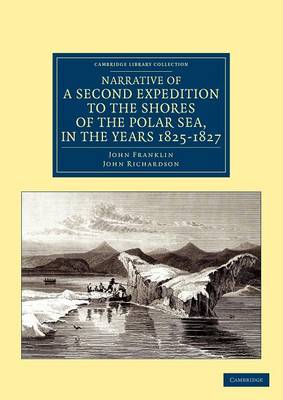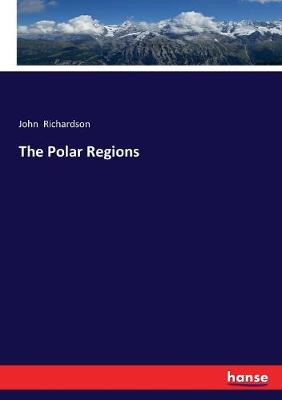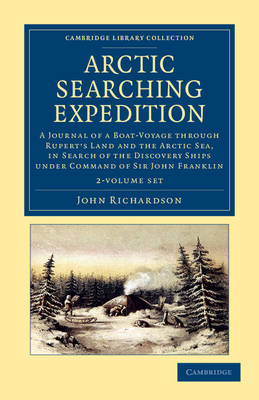Cambridge Library Collection - Polar Exploration
2 primary works • 6 total works
Volume 1
The surgeon, naturalist and Arctic explorer Sir John Richardson (1787-1865) was a lifelong friend to his former commander Sir John Franklin, with whom he had twice travelled to seek the North-West Passage. Following two years of silence from Franklin after he embarked on his 1845 expedition to the Arctic, Richardson set out on his own voyage in the hope of finding his comrade. Originally published in 1851, this two-volume work charts the journey which would inevitably fail in its ambition: Franklin, unknown to Richardson, had already died in June 1847. Volume 1, which depicts the journey to Fort Confidence in the Canadian Arctic, ends with detailed descriptions of the aboriginal Inuit and Gwich'in peoples encountered. The text is punctuated throughout by accounts of the wildlife and geographical features sighted, and the customs and cultures observed on this remarkable mission.
Volume 2
The surgeon, naturalist and Arctic explorer Sir John Richardson (1787-1865) was a lifelong friend to his former commander Sir John Franklin, with whom he had twice travelled to seek the North-West Passage. Following two years of silence from Franklin after he embarked on his 1845 expedition to the Arctic, Richardson set out on his own voyage in the hope of finding his comrade. Originally published in 1851, this two-volume work charts the journey which would inevitably fail in its ambition: Franklin, unknown to Richardson, had already died in June 1847. Volume 2 begins with detailed descriptions of the aboriginal Chipewyan and Cree peoples. A thorough appendix comprises observations on physical geography, climatology and the geographical distribution of plants, and includes vocabularies for the dialects encountered during the mission. The text ends, Richardson having returned, with the hope that future expeditions may yet trace 'so many gallant victims to science'.
Narrative of a Second Expedition to the Shores of the Polar Sea, in the Years 1825, 1826, and 1827
by Sir John Franklin and John Richardson
Published 26 January 2012
Sir John Franklin (1786-1847) joined the Navy at the age of fourteen and saw action at Copenhagen and Trafalgar. Between those battles, he circumnavigated Australia with his uncle, Matthew Flinders; he became famous after his first major expedition to northern Canada in 1819-22, although it resulted in the deaths of over half of his men. Accounts of both of these voyages are also reissued in this series. Franklin returned to the Arctic in 1825, and this, his second book, describes that more successful endeavour. Published in 1828, it records the expedition's planning, route, scientific observations, and the mapping of over 1200 miles of Canada's northern coastline. The party included two artists, and their work is reproduced in over thirty engravings. Franklin was later posted to the Mediterranean and Tasmania, but in 1845 embarked on his disastrous third expedition to the North-West Passage, during which he and his entire crew were lost.
The Arctic explorer Sir John Richardson (1787-1865), who had accompanied both John Franklin and John Rae on major expeditions, expands here an article which had appeared in the Encyclopaedia Britannica. Organised in two parts, and published in 1861, this work covers first the Arctic and then the largely unexplored Antarctic. Adopting a chronological approach in the first part, Richardson covers Roman knowledge of the far north, Norse voyages, and later exploration by the British, Dutch and Russians. He then deals in detail with the search for the North-West Passage, including the expeditions in search of Sir John Franklin. Later chapters cover Spitsbergen, Arctic weather, ice, currents, geology, vegetation and zoology, as well as the three principal groups of native people: the Inuit, Lapps and Samoyeds. In the second part, Richardson outlines Antarctic exploration since 1576, providing an overview of what little was known of this part of the globe.
Naval surgeon, Arctic explorer and natural historian, Sir John Richardson (1787–1865) published many works, several of which are reissued in the Cambridge Library Collection, notably the four-volume Fauna Boreali-Americana. At the Haslar Royal Naval Hospital, where he worked towards the end of his career, Richardson built up a library and museum that became renowned for natural history research. His published work was fuelled by his own voyages and the specimens sent back from other expeditions, as was the case for this illustrated work, completed in 1854. Richardson describes the zoological specimens collected during the 1845–51 voyage of the survey ship H.M.S. Herald, which had sailed into Arctic seas and took part in the search for Sir John Franklin. The collected fauna include fossil mammals from the ice cliffs at Eschscholtz Bay in Alaska, first discovered in 1816 by Otto von Kotzebue and his naturalists.
The surgeon, naturalist and Arctic explorer Sir John Richardson (1787-1865) was a lifelong friend to his former commander Sir John Franklin, with whom he had twice travelled to seek the North-West Passage. Following two years of silence from Franklin after he embarked on his 1845 expedition to the Arctic, Richardson set out on his own voyage in the hope of finding his comrade. Originally published in 1851, this two-volume work charts the journey which would inevitably fail in its ambition: Franklin, unknown to Richardson, had already died in June 1847. Volume 1 depicts the journey to Fort Confidence in the Canadian Arctic, ending with detailed descriptions of the aboriginal Inuit and Gwich'in peoples encountered. Volume 2 begins with detailed descriptions of the Chipewyan and Cree peoples. A thorough appendix comprises observations on physical geography, climatology and the geographical distribution of plants, and includes vocabularies for the dialects encountered.



